
Glaucocharis chrysochyta is a species of moth in the family Crambidae. This species was first described by Edward Meyrick in 1882. It is endemic to New Zealand and is found throughout the country. It inhabits native forest. Larvae appear to feed on moss and likely pupate there. Adult moths are on the wing from November to March. They fly at night and are attracted to light.
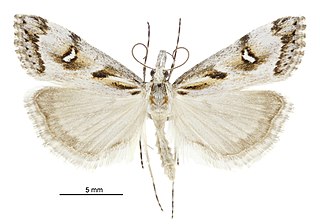
Gadira leucophthalma, the beaked moss moth, is a moth in the family Crambidae. It is endemic to New Zealand. It is found in the south eastern side of the South Island down to Banks Peninsula. G. leucophthalma inhabits the foredunes of coastal areas. The larval host is unknown but it has been hypothesised that the larvae feed on moss. The adult moths are day flying although some specimens have been trapped at night via light traps. Adults are commonly on the wing from March to April. This species has been classified as Nationally Vulnerable by the Department of Conservation.

Glaucocharis auriscriptella, also known as the yellow silverling or silver marked yellow, is a moth in the family Crambidae. It was first described by Francis Walker in 1864 and is endemic to New Zealand. This species can be found in the North, South, Stewart and Great Barrier Islands. The preferred habitat of this moth is lowland and subalpine native forest as well as wetlands. The larvae feed on moss. The adult moth is day flying and is on the wing from November to February. It can be observed in colonies and can be attracted to light at night. This species likely has only one generation per year.

Glaucocharis epiphaea is a species of moth in the family Crambidae. It was described by Edward Meyrick in 1885. It is endemic to New Zealand and has been observed in both the North and South Islands. G. epiphaea prefers mountainous habitat and frequents very damp spots including alpine and subalpine moss bogs. Larvae feed on the moss Dawsonia superba. Adults are on the wing from September until March and are diurnal.
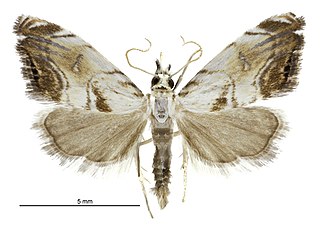
Glaucocharis harmonica is a moth in the family Crambidae. This species was described by Edward Meyrick in 1888. It is endemic to New Zealand and is found in the North and South Islands. It inhabits lowland to subalpine native forest. It has been hypothesised that there are two broods per year. The larval hosts are unknown. Adults are on the wing from October until January.
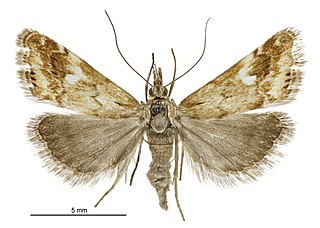
Glaucocharis helioctypa is a moth in the family Crambidae. It was first described by Edward Meyrick in 1882. It is endemic to New Zealand and is only found in the South Island. It can be found throughout the South Island and inhabits native forest in lowland to subalpine altitudes. It has an affinity for damp grassy open situations near native forest or scrub. Larvae of Glaucocharis species feed on mosses and liverworts. Adults are on the wing from November until February. It is dayflying and has been observed flying low over cushion bogs and moss fields. Adults have also been observed flying actively in the hottest sunshine.
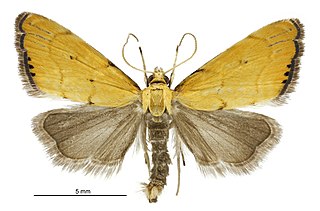
Glaucocharis holanthes is a moth of the family Crambidae. It was first described by Edward Meyrick in 1885. It is endemic to New Zealand and is found in the North and South Islands. This species inhabits native forest or scrub and frequents rock-faces where moss grows. It is apparently attached to places having an exceptionally heavy rainfall. Larvae of Glaucocharis species feed on mosses and liverworts. Adults are on the wing from November to February. It flies very rapidly in hot sunshine and is an elusive insect to catch.

Glaucocharis leucoxantha is a moth in the family Crambidae. It was first described by Edward Meyrick in 1882. It is endemic to New Zealand and can be found in the North, South and Stewart Islands. This species inhabits native forest. Hudson states this species can be met with in South Island native beech forests at elevations of from 1,500 to 2,500 feet above the sea-level. Larvae of Glaucocharis species feed on mosses and liverworts. Adults are on the wing from November until February. This species is very variable in colouration and can be confused with G. lepidella. However it is smaller in size and the crescent shaped spot on its forewings is white or yellow rather than the silver of G. lepidella.
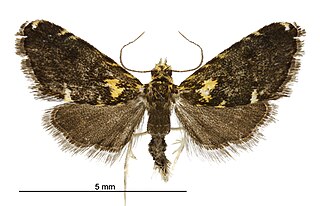
Glaucocharis microdora is a moth of the family Crambidae. It was first described by Edward Meyrick in 1905. It is endemic to New Zealand and is found in the southern parts of the North Island and the north and central parts of the South Island. It inhabits native forest at lowland to subalpine altitudes. The larvae of this species feeds on moss and adults are on the wing from November until February. It is similar in appearance to G. pyrsophanes but can be distinguished as G. microdora is of a smaller size and has bright yellow markings. It also lacks the broad white bars on forewings of G. pyrophanes.

Glaucocharis parorma is a moth of the family Crambidae. It was first described by Edward Meyrick in 1924. It is endemic to New Zealand and is found in the North Island. This species inhabits native forest from lowland to subalpine altitudes. Larvae of Glaucocharis species feed on mosses and liverworts. Adults are on the wing from October to February. This species is very similar in appearance to G. elaina but can be distinguished as a result of the black terminal dots on its forewings.
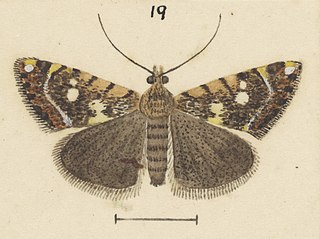
Glaucocharis planetopa is a moth of the family Crambidae. It was first described by Edward Meyrick in 1923. It is endemic to New Zealand and has only be observed on the South Island. G. planetopa inhabits native forest. Larvae of Glaucocharis species feed on mosses and liverworts. Adults are on the wing in January and February. As at 1971 the female of this species had yet to be collected.

Glaucocharis pyrsophanes is a moth in the family Crambidae. It was described by Edward Meyrick in 1882. It is endemic to New Zealand and is found throughout the country including the North, South and Stewart Islands. It inhabits native forest from lowland and subalpine altitudes. It is said to be common in sunny but damp forest openings. Larvae of Glaucocharis species feed on mosses and liverworts. Adults are on the wing from October until February. They are known to feed from and pollinate Leptospermum scoparium and Helichrysum selago.
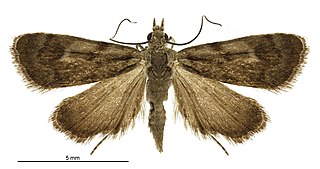
Glaucocharis stella is a species of moth in the family Crambidae. This species was first described by Edward Meyrick in 1938. It is endemic to New Zealand and has been observed in the North Island. Meyrick hypothesised that larvae of G. stella feed on moss. Adults are on the wing in October and November. The colouration of the forewings ensure that when resting with closed wings on rocks adults are highly camouflaged.

Tingena ancogramma is a species of moth in the family Oecophoridae. It is endemic to New Zealand and has been found in the Hen and Chicken Islands, the North Island and the South Island. Adults are on the wing in summer and autumn and inhabit open areas of forest scrubland.

Tingena hemimochla is a species of moth in the family Oecophoridae. It is endemic to New Zealand and has been observed in the North Island. Adults of this species are on the wing from December until March.

Tingena oxyina is a species of moth in the family Oecophoridae. It is endemic to New Zealand and has been observed in the Otago region. This species inhabits native beech forest at altitudes of between 1000 – 3000 ft. Adults of this species are on the wing in January.

Chalastra aristarcha, the silver fern moth, is a moth of the family Geometridae. This species was first described by Edward Meyrick in 1892. It is endemic to New Zealand and is found in the North Island. This species inhabits dense native forest. The larvae feed on the species host plant, the Silver fern, during spring. This species then pupates on top of leaf litter or moss on the ground. The pupation state lasts for approximately 6 weeks. Adult moths are on the wing from October until April but can sometimes also be seen during the winter months. Adults can be disturbed from silver ferns during the day or are seen on the wing at night particularly at Metrosideros perforata when in flower. Adults are attracted to light. It has been hypothesised that the range of C. aristarcha has restricted as a result of urban development and land conversion of its habitat.
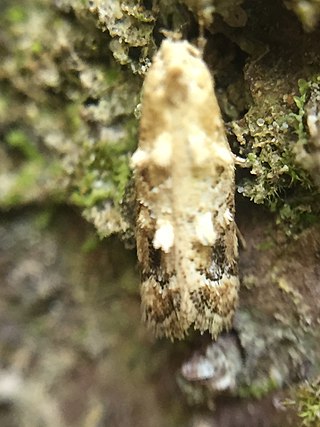
Trachypepla aspidephora is a species of moth in the family Oecophoridae. It is endemic to New Zealand and has been observed in the North and South Islands. Adults are on the wing from November to March and are attracted to light. The moths can be found resting on tree trunks where their colouration imitates lichens.

Atomotricha exsomnis is a moth in the family Oecophoridae. It was first described by Edward Meyrick in 1913. It is endemic to New Zealand and can be found in both the North and South Islands. Adults are on the wing from November until January.

Trachypepla photinella is a moth of the family Oecophoridae first described by Edward Meyrick in 1883. It is endemic to New Zealand and has been collected in Wellington, Wainuiomata, D'Urville Island and Christchurch. The preferred habitat of this species is native forest and adults are on the wing from December until February.






















